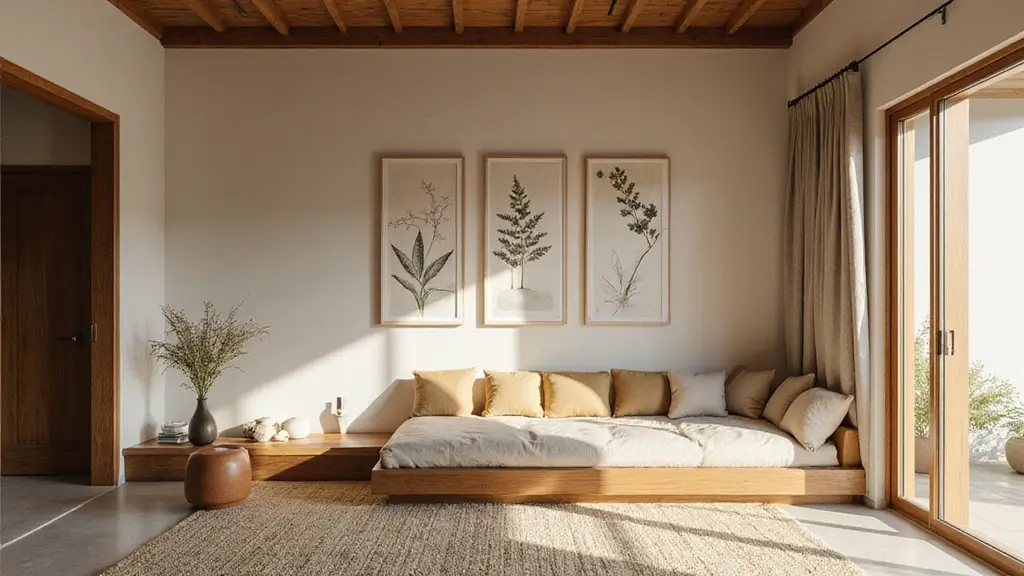Minimalism meets the deep-rooted culture of India in striking ways that modernize living spaces while staying true to tradition.
These minimalist Indian home ideas not only create a serene atmosphere but also celebrate the rich heritage and craftsmanship of India.
Whether you’re drawn to fluid designs or love the charm of intricate details, these ideas will inspire you to transform your home into a peaceful, stylish sanctuary adorned with cultural accents and sustainable materials.
1. Natural Wood Accents
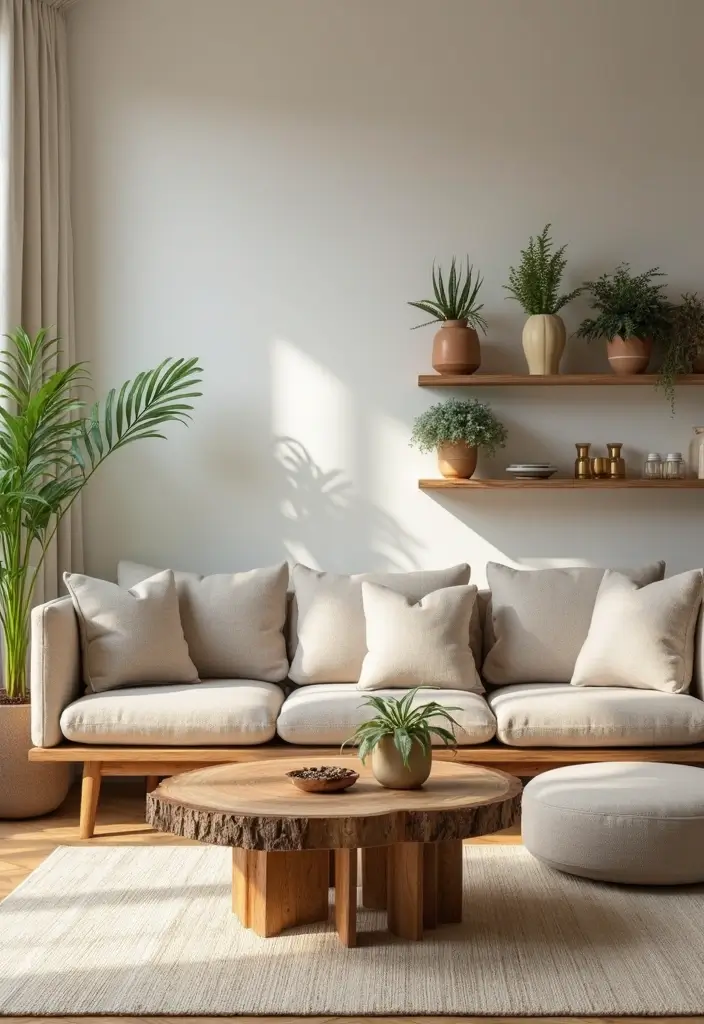
Nothing elevates minimalist decor like the warmth of natural wood.
Incorporate wooden furniture crafted from reclaimed sources for sustainability. Imagine a sleek, low-profile coffee table made from a single slab of teak, paired with simple, upholstered chairs. This not only adds an organic touch but ensures that each piece tells a story of craftsmanship.
Opt for pieces with clean lines to maintain that minimalist feel. Some ideas include:
– Reclaimed wood shelves for books or decor.
– Wooden frames for photos or artwork that add a hint of personal touch.
– A wooden bed frame with a simple design that anchors your bedroom.
Remember to keep the finishes natural to enhance the beauty of the wood grain.
2. Subtle Earthy Tones
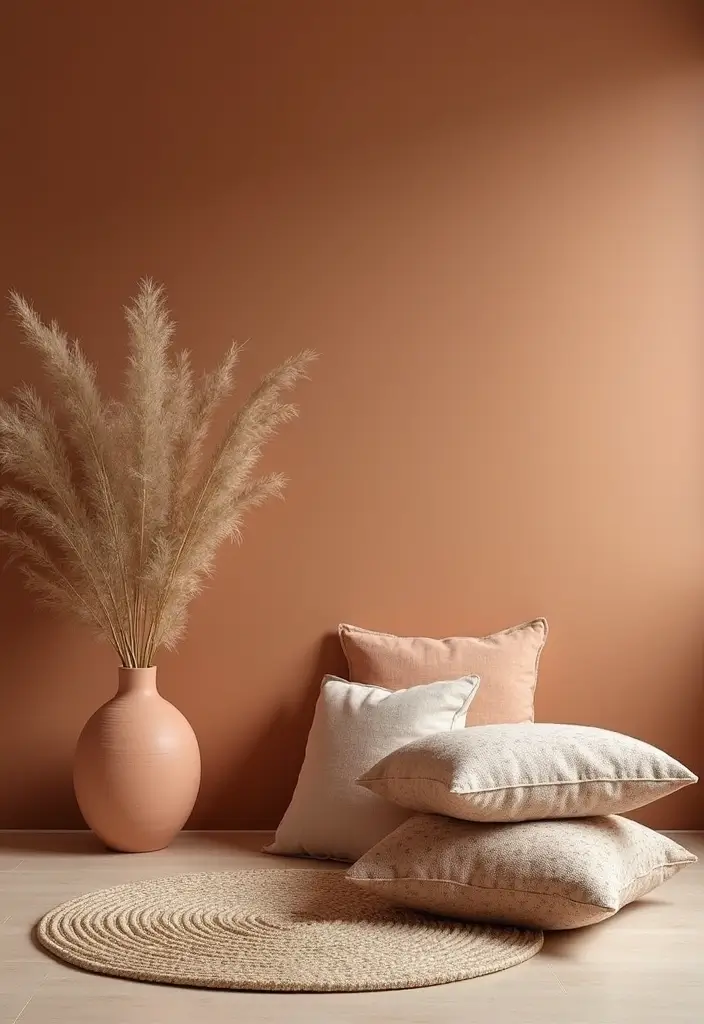
Creating an inviting atmosphere with earthy tones can be both calming and stylish.
Colors like terracotta, muted greens, and soft browns connect your space to nature. Try painting your walls a gentle beige or using clay tiles that reflect traditional crafting techniques. These choices add depth without overwhelming the senses.
Decorate with:
– Throw pillows in earthy hues to add comfort and texture.
– A terracotta vase as a focal point on a neutral table.
– Handwoven rugs in natural fibers to ground the space.
This color palette not only ties in cultural elements but creates a soothing environment that resonates with minimalism.
3. Traditional Textiles with a Twist
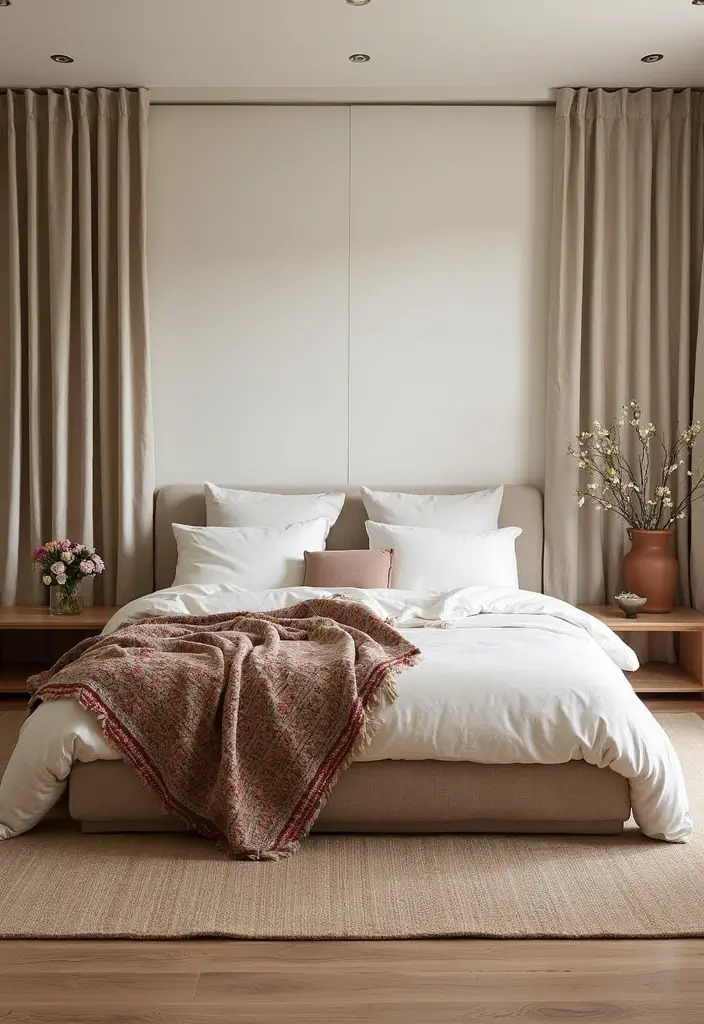
Incorporate traditional Indian textiles in a minimalist way by choosing simple patterns or monochromatic prints.
Think block-printed cushions with a subtle design or a lightweight throw made from organic cotton. These textiles can add a layer of softness and bring cultural heritage into your home without heavy ornamentation.
Ideas include:
– Lightweight curtains made from khadi fabric for airiness.
– A single kantha-stitched throw draped over a chair for a pop of texture.
– A minimalist bedspread that features a simple geometric pattern inspired by Indian art.
This approach maintains the essence of Indian crafts while embracing a clean aesthetic.
4. Indoor Plants for Freshness
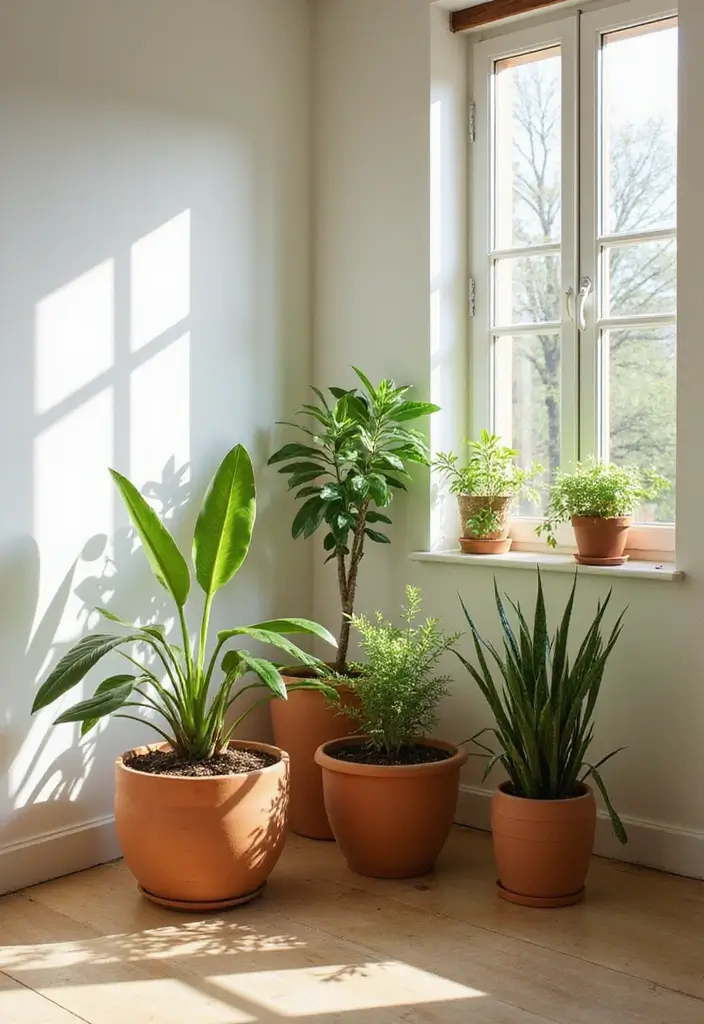
Adding greenery can breathe life into a minimalist Indian home.
Choose plants that not only purify the air but also create a serene atmosphere. Opt for low-maintenance options like snake plants or peace lilies, placed in handcrafted terracotta pots. The contrast of green against earthy materials is visually striking.
Some tips for incorporating plants:
– Use hanging planters to save floor space.
– Group plants of varying heights for a layered effect.
– Consider a vertical garden in a corner to maximize space.
With plants, you not only enhance aesthetics but also embrace sustainability in your living environment.
Breathe life into your minimalist Indian home! A few well-placed plants not only purify the air but also create an inviting atmosphere. Remember, a touch of green can transform your space into a tranquil oasis.
5. Open Shelving with Cultural Artifacts
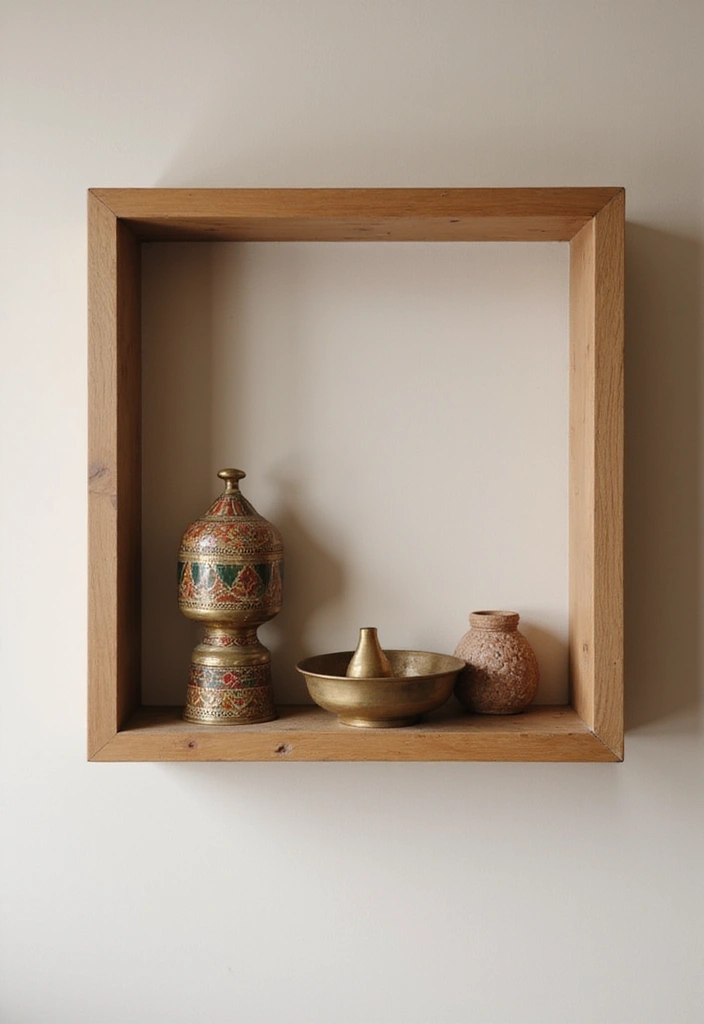
Open shelving is a fantastic way to display your love for culture without creating clutter.
Select a few curated pieces that reflect your heritage, like a brass diya (lamp) or a hand-painted pottery item, and place them against a clean backdrop. This approach creates visual interest while maintaining simplicity.
Consider these points:
– Limit the number of items for a clean look.
– Mix textures by combining wooden shelves with ceramic or metal artifacts.
– Use lightweight elements to prevent overwhelming the space.
This minimalist display allows you to infuse personality into your home while celebrating Indian crafts.
6. Minimalist Lighting Fixtures
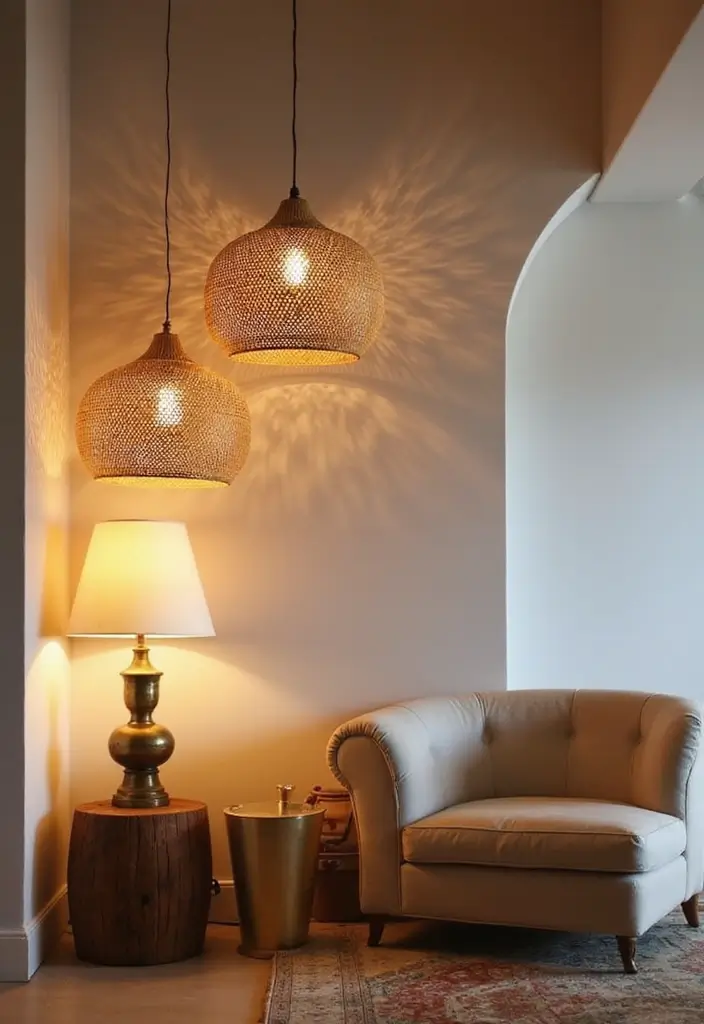
Choosing the right lighting can dramatically affect the overall vibe of your home.
Select fixtures that reflect modern Indian design, like rattan pendant lights or elegant brass lamps. These not only serve a purpose but also infuse warmth and style into your space.
When selecting lighting:
– Layer your lighting with different sources, such as floor lamps, table lamps, and ceiling fixtures.
– Pick adjustable fixtures for versatility in mood setting.
– Ensure your light bulbs are energy-efficient to embrace sustainability.
Good lighting can highlight other minimalist decor elements while adding cultural charm.
7. Simplistic Wall Art
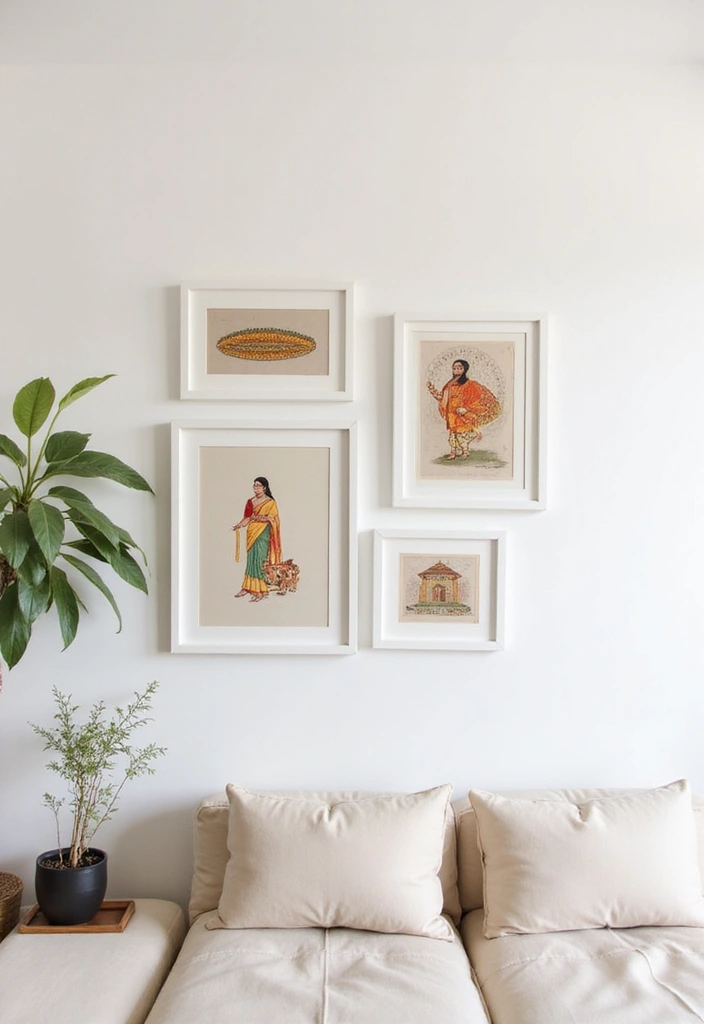
Art is a wonderful way to express your personal style while keeping things minimal.
You don’t need oversized paintings; instead, consider smaller framed pieces or even traditional Indian art styles like Madhubani in understated colors. A gallery wall can be created with small frames in a clean layout.
Here are some suggestions:
– Use a monochromatic color scheme for a cohesive look.
– Integrate handcrafted items like woven wall hangings for texture.
– Consider placing art at eye level to enhance visual engagement.
Art can tell a story while adhering to minimalist principles, enriching your home’s atmosphere.
8. Floor Seating for Versatility
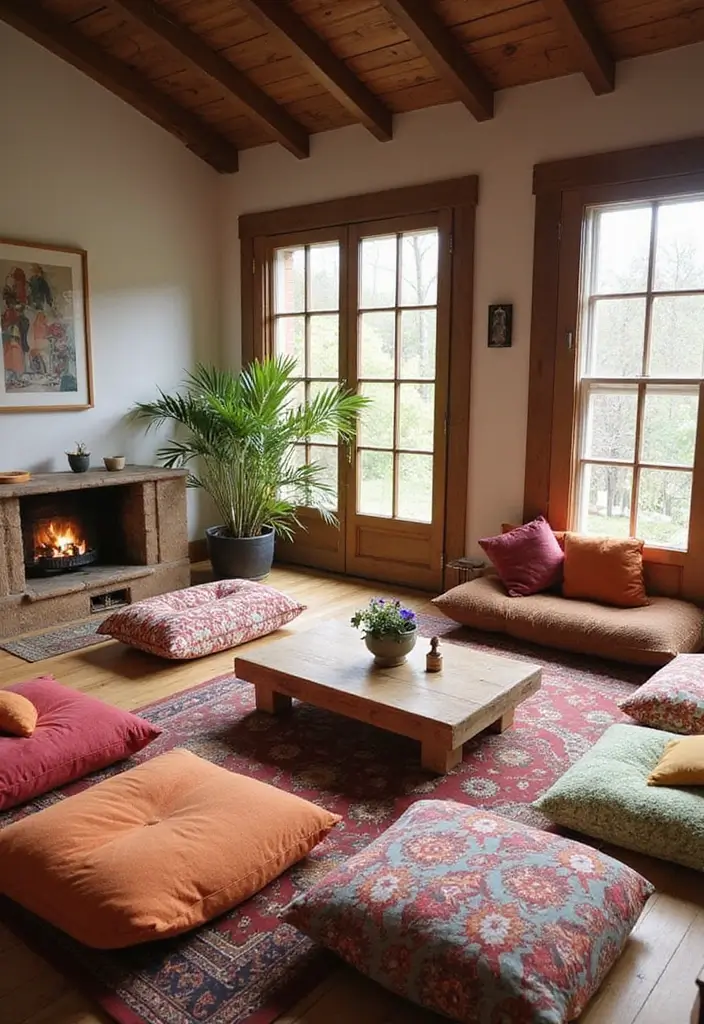
Floor seating is a wonderful way to create an inviting and flexible living space.
Incorporate floor cushions or low-cushioned chairs made from organic fabrics that invite comfort and relaxation. Convert any room into a cozy nook for gathering friends or unwinding with a book.
To enhance this setup:
– Use removable covers for easy cleaning.
– Layer cushions of various sizes and textures for depth.
– Add a low table for snacks and drinks, tying it all together.
This design not only saves space but also infuses a casual elegance reminiscent of traditional Indian hospitality.
Transform your minimalist Indian home into a cozy haven! Floor seating invites warmth and flexibility, creating the perfect spot for relaxation and connection.
9. Natural Stone Elements
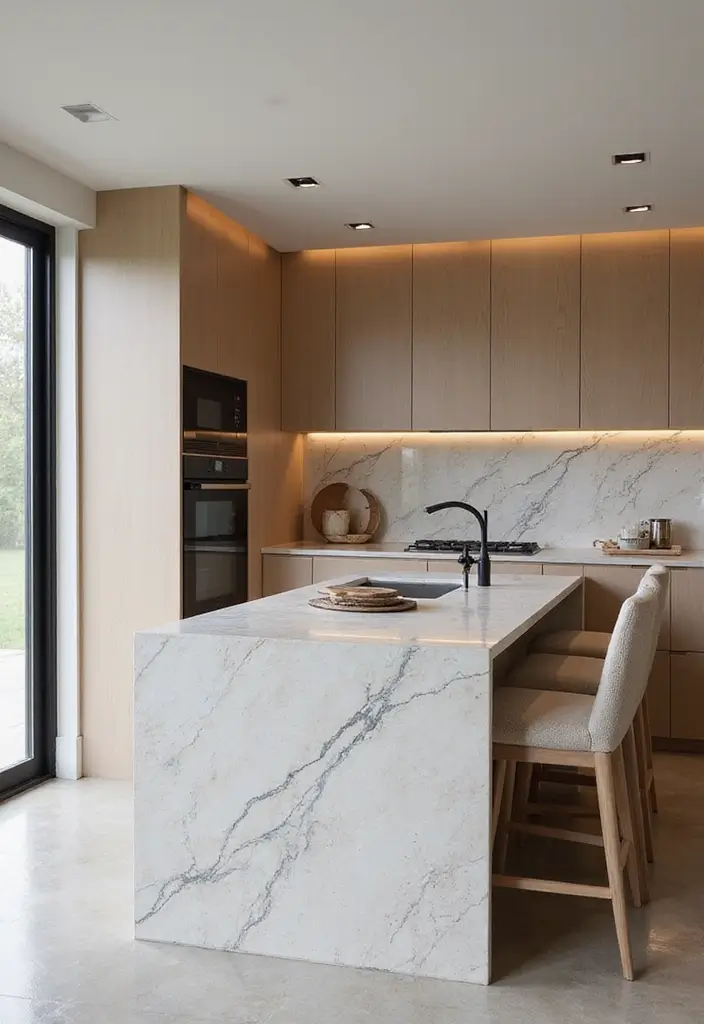
Incorporating natural stone elements can elevate your minimalist decor beautifully.
From granite countertops to marble accents, these materials add a timeless quality to your space. Choose sustainability by sourcing locally to reduce your carbon footprint.
Ideas include:
– A stunning stone slab table as a centerpiece.
– Stone lamps featuring geometric designs for a modern touch.
– Accent walls made from locally sourced stone for texture and depth.
Natural stone not only offers durability but also connects your home to the earth, aligning perfectly with a minimalist aesthetic.
10. Zen Garden Spaces
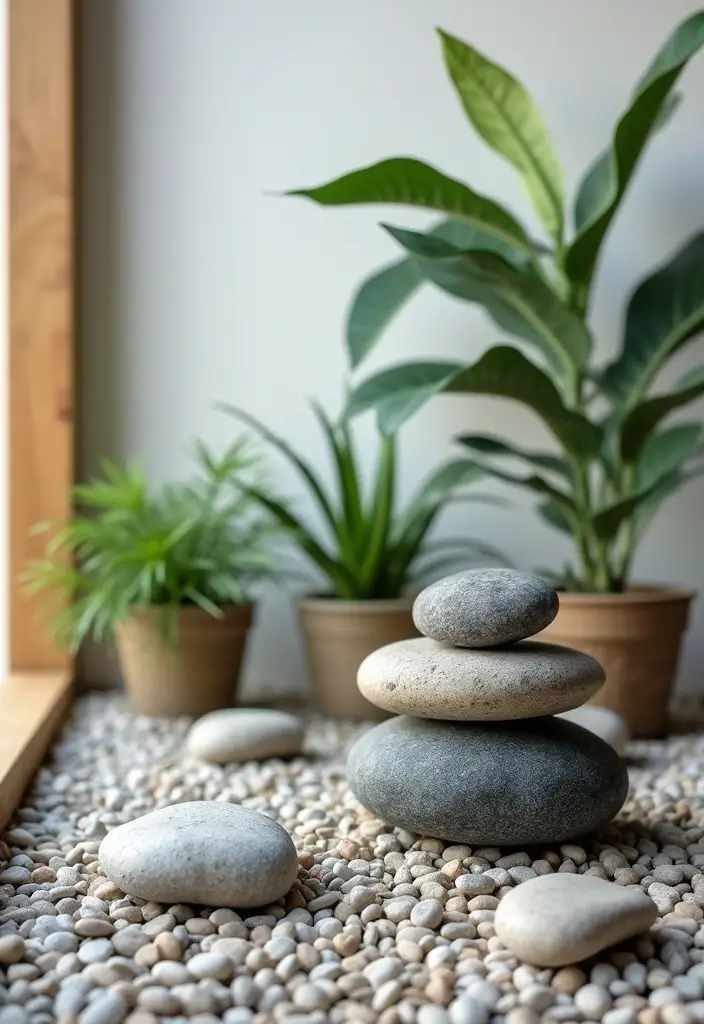
A minimalist Indian home can greatly benefit from a zen garden space, allowing for tranquility and reflection.
This could be a small corner in your house with pebbles, a few carefully placed plants, and stones arranged artistically. Try to keep the layout simple and serene.
Consider:
– Using natural stones for a grounded feel.
– Introducing a small water feature for calming sounds.
– Arranging plants in a way that they require minimal maintenance.
Creating a zen corner enhances mindfulness and adds a serene escape from the daily bustle.
11. Cultural Pottery Display
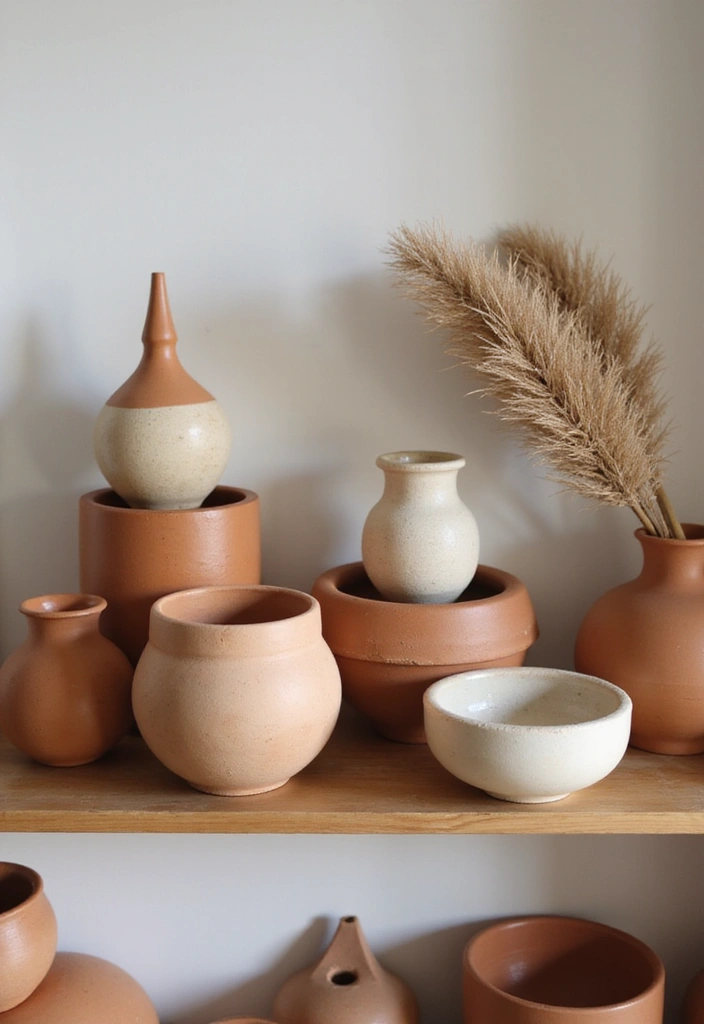
Showcasing cultural pottery as decor can add richness to your minimalist home.
Handcrafted pieces, like terracotta or ceramic pots, bring texture and color to your spaces. You can create a display by grouping together pots of varying heights for visual interest without clutter.
For an engaging display:
– Choose pots in earthy tones that complement your color scheme.
– Mix and match styles – from modern to traditional – to create contrast.
– Use shelves or a dedicated tabletop to arrange them thoughtfully.
This approach allows cultural elements to shine through while maintaining a minimalist vibe.
12. Simple Geometric Patterns
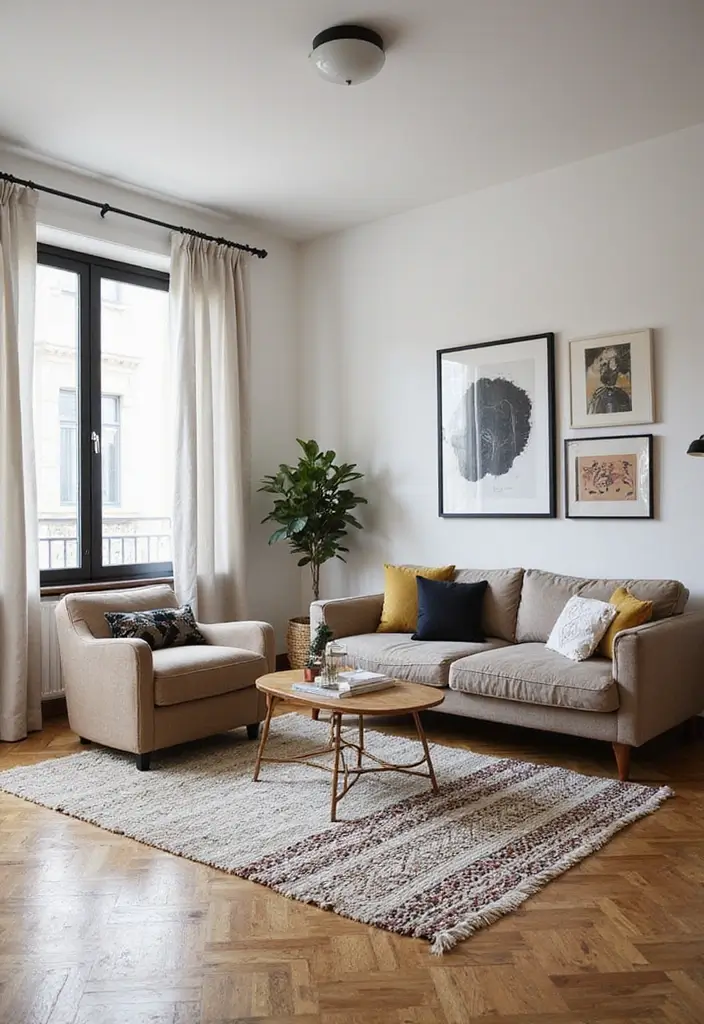
Incorporating simple geometric patterns can add a modern touch to your minimalist decor.
Think of rugs or wall art that features clean lines and shapes inspired by traditional Indian art, providing visual interest without overwhelming your space.
Consider:
– A low-pile rug with a subtle geometric design under your coffee table.
– Framed wall art showcasing geometric motifs that tie into your color scheme.
– Cushions with simple patterns that complement your overall aesthetic.
This fusion of old and new ensures that while the decor feels modern, it still honors its cultural roots.
Embrace the beauty of simplicity! A low-pile rug or a piece of wall art with geometric patterns can elevate your minimalist Indian home while honoring tradition. Less is truly more!
13. Fusion of Modern and Traditional Furniture
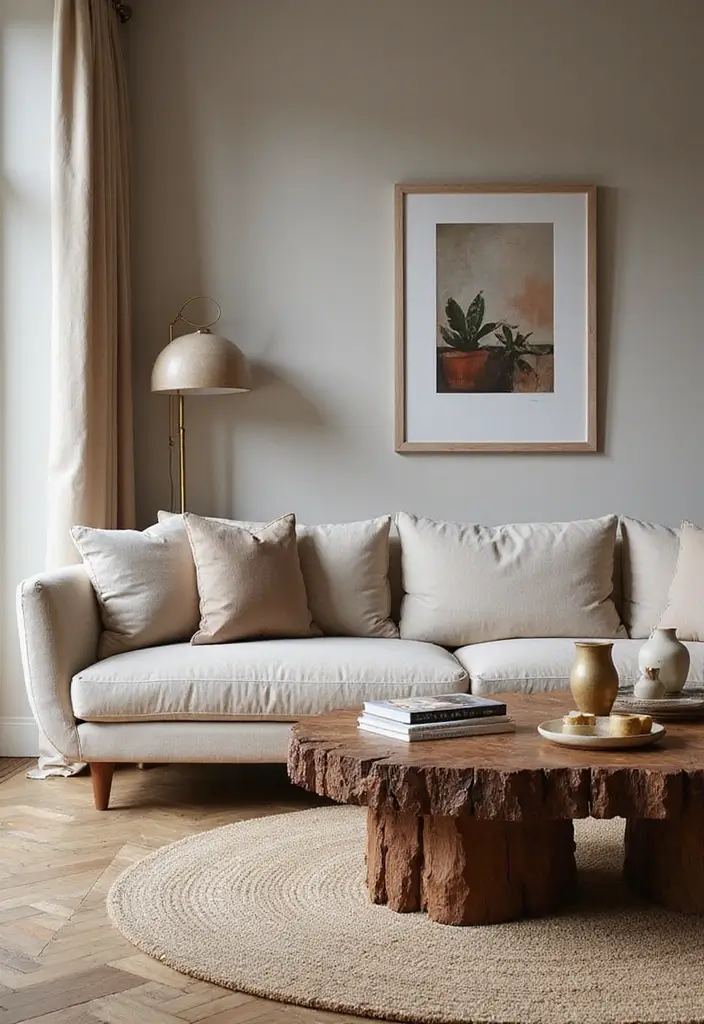
Mixing modern furniture with traditional Indian pieces can create a stunning contrast in your home.
For example, a sleek modern sofa paired with a carved wooden coffee table combines styles elegantly. The key is ensuring balance, so neither style overpowers the other.
include:
– Look for contemporary seating that has a traditional touch, like a jute or cane finish.
– Use traditional storages, like a wooden trunk, as a coffee table for character.
– Keep furnishings in harmony through color coordination.
This balance enhances your minimalist ethos while celebrating cultural nuances.
14. Colorful Accent Walls
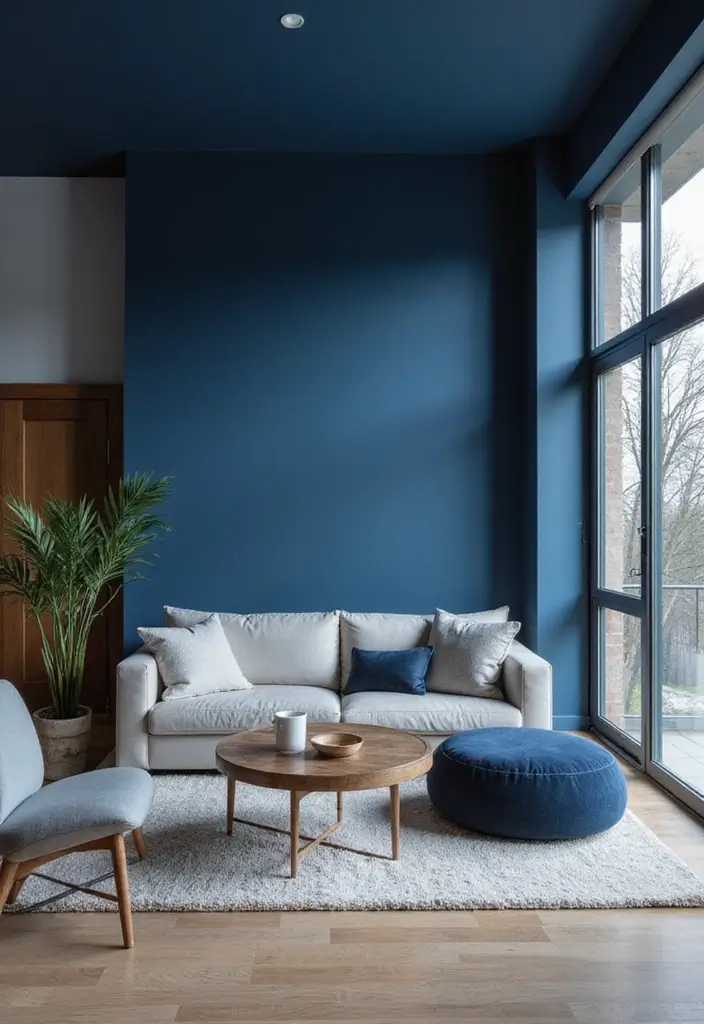
A bold accent wall can be a fantastic focal point in a minimalist home without overwhelming it.
Consider using a deep color inspired by traditional Indian shades, such as indigo or mustard, to create contrast. This draws the eye and adds warmth to the room.
Here are some ideas:
– Choose a wall that naturally draws attention, like behind a sofa or bed.
– Consider hand-painted murals or stencils to add cultural significance.
– Balance the vibrant wall with neutral furnishings to keep the space open.
These bold choices enhance the minimalist approach while embracing Indian heritage.
A colorful accent wall isn’t just a design choice; it’s a storytelling canvas! Embrace traditional Indian hues like indigo or mustard to bring warmth and culture into your minimalist Indian home.
15. Minimalist Kitchen Concepts
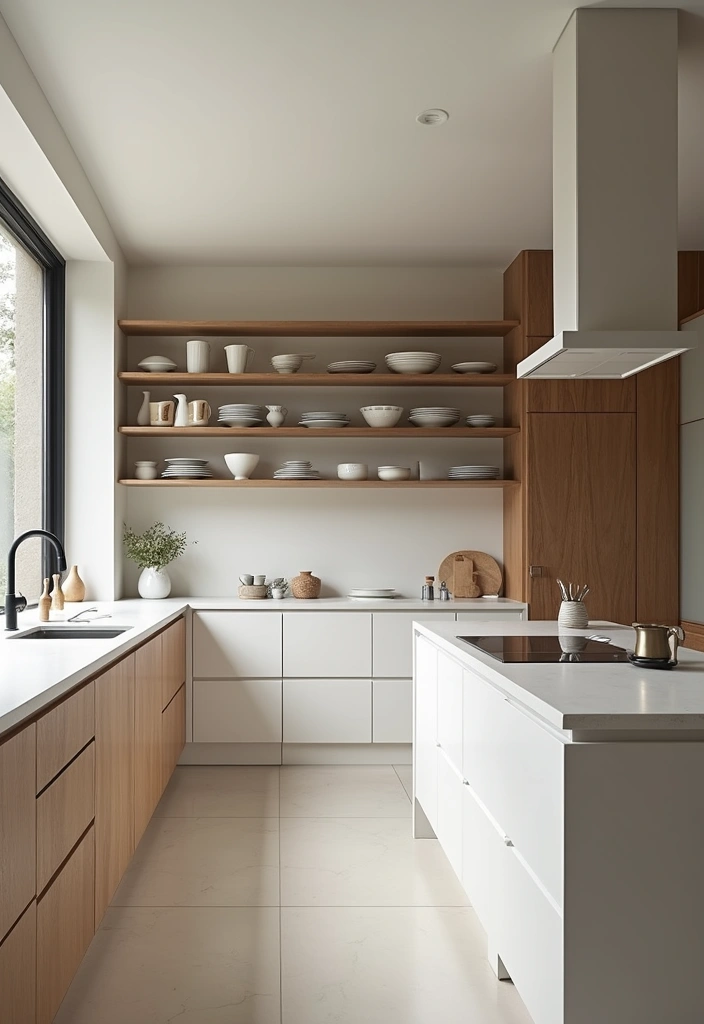
Create a minimalist kitchen that showcases simplicity and functionality.
Focus on clean lines, a clutter-free countertop, and smart storage solutions. Use wooden or stone finishes that echo natural materials, maintaining a connection to sustainability.
Some concepts include:
– Open shelves to display elegant dishware, keeping essentials visible yet tidy.
– A large central island for cooking and gathering, designed with simple materials.
– Use of energy-efficient appliances that blend into cabinetry for a seamless look.
These designs create an inviting cooking space that is both practical and stylish.
16. Minimalistic Home Office

A minimalist home office can boost productivity while reflecting your personal style.
Incorporate a simple desk made of sustainable materials, paired with an ergonomic chair that maintains both comfort and style. Keep the decor minimal, focusing on functionality without clutter.
Ideas include:
– Wall-mounted shelves to keep books handy yet organized.
– A single art piece that inspires creativity while keeping the aesthetic clean.
– Good lighting from natural and artificial sources for an uplifting atmosphere.
A thoughtfully designed workspace fosters creativity while reflecting the calm of minimalism.
17. Light, Airy Spaces
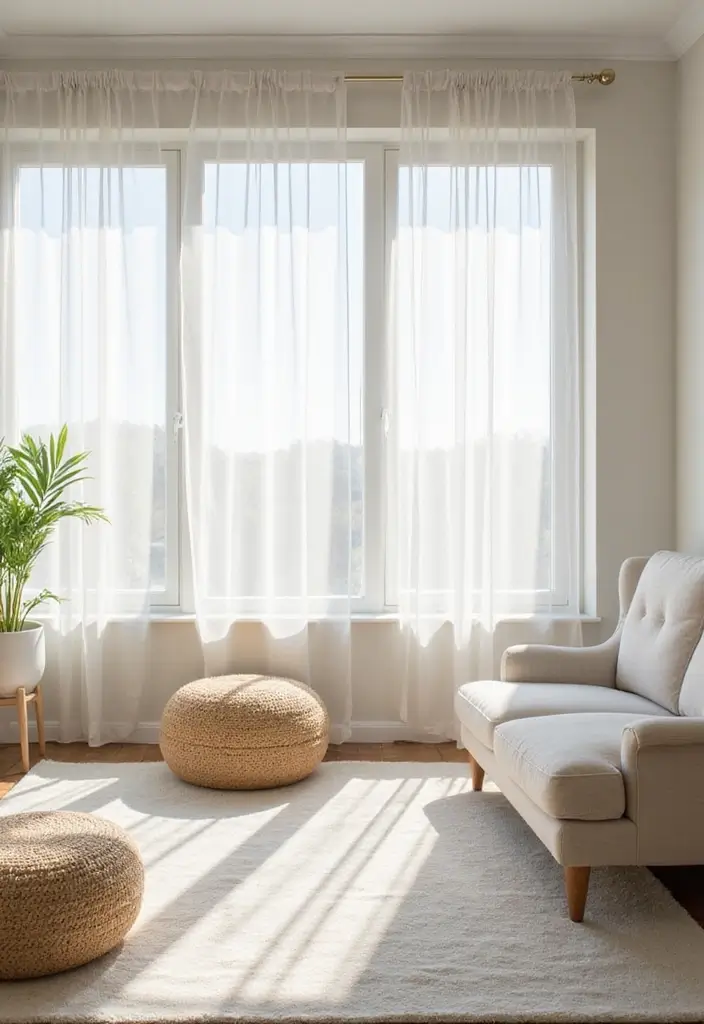
Creating light and airy spaces is key to achieving a minimalist aesthetic.
Maximize natural light with large windows and choose sheer curtains that allow sunlight to filter through gently. This principle not only creates an illusion of space but also enhances your connection to the outdoors.
for lightening your space:
– Use reflective surfaces like mirrors to bounce light around.
– Keep furniture low and light-colored to maintain a spacious feel.
– Declutter regularly to ensure an open atmosphere.
These choices can transform your home into a serene haven filled with positivity.
18. Incorporating Cultural Icons
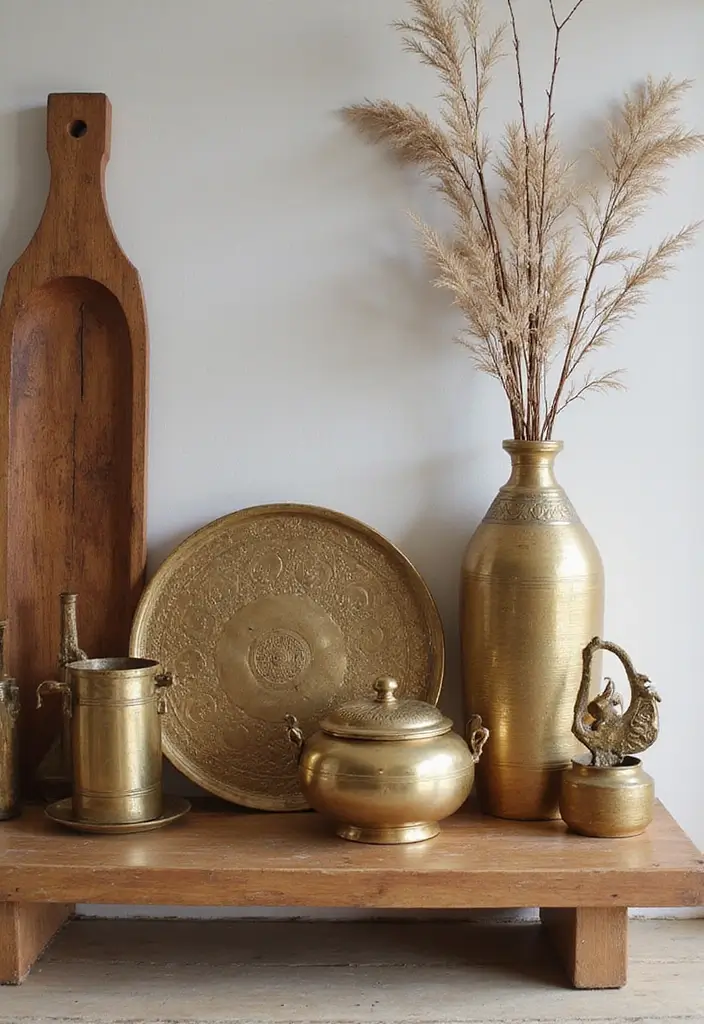
Cultural icons can add richness to a minimalist decor style.
Focus on a few key pieces that resonate with your Indian heritage, like a traditional brass bell or a hand-carved wooden figurine. These pieces can become conversation starters while reinforcing your cultural identity.
Consider:
– Placing them in strategic spots to catch the eye without overwhelming.
– Ensuring the colors and materials align with your minimalist palette.
– Choosing replicas or modern interpretations for a twist on tradition.
This tasteful approach keeps the decor meaningful yet simple.
19. Neutral Color Palette
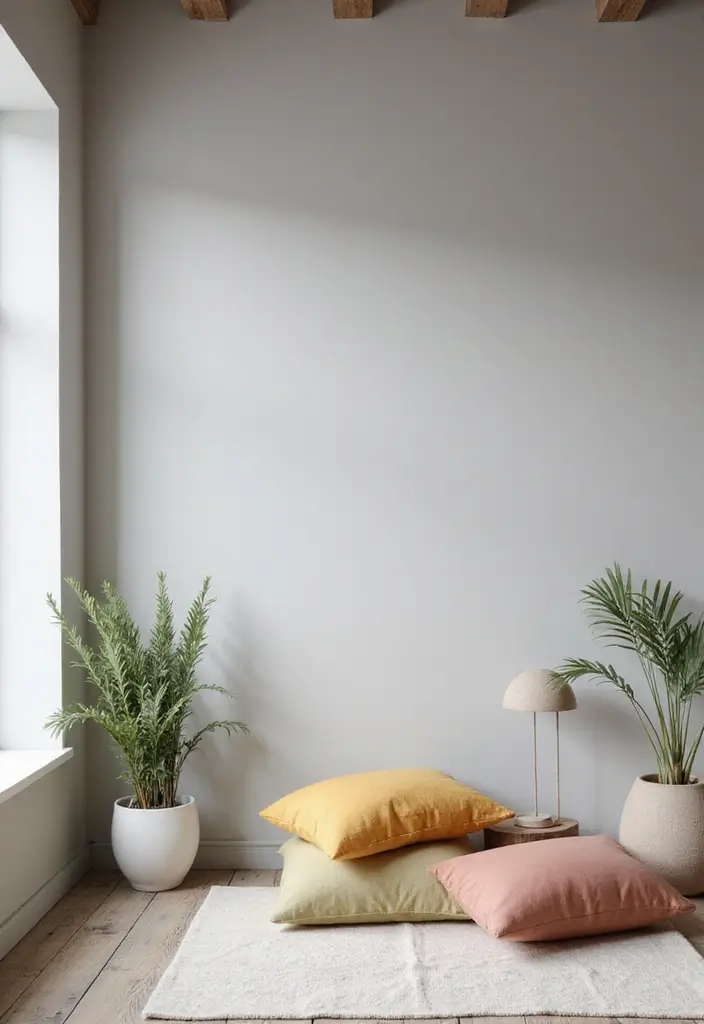
A neutral color palette serves as the perfect backdrop for minimalist Indian decor.
Colors like white, beige, and soft grays provide a calming effect while allowing vibrant cultural accents to stand out. This approach creates a peaceful and stylish environment without overwhelming the senses.
To implement:
– Use neutral shades on the walls and larger furniture pieces.
– Add pops of color through accessories like cushions or art.
– Consider varying textures to keep the space lively.
A neutral palette is timeless, ensuring your home feels contemporary yet welcoming.
20. Mindful Organization
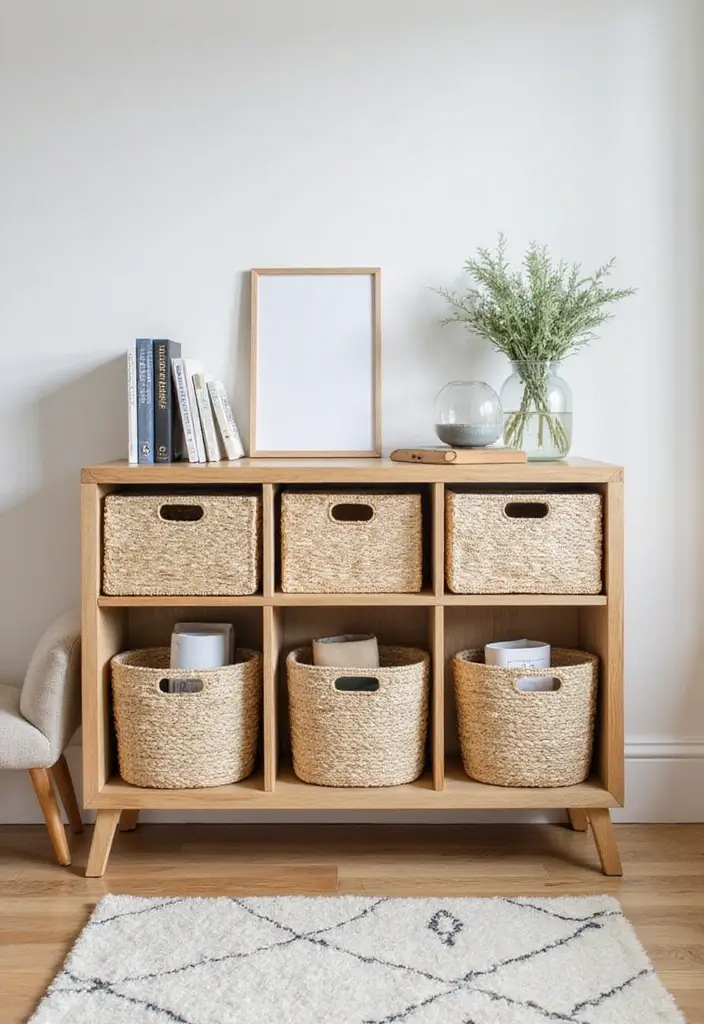
Mindful organization is fundamental in a minimalist home.
Use baskets made from natural fibers to keep items tidy yet accessible, blending functionality with aesthetics. This approach can help eliminate clutter while enhancing the visual appeal of your space.
Consider these methods:
– Labeling baskets or containers to maintain order.
– Keeping frequently used items at hand, while storing less-used items out of sight.
– Arranging books or decor by color for a harmonious look.
Mindful organization ensures your home remains serene and visually pleasing, reflecting your minimalist lifestyle.
21. Sustainable Materials in Decor
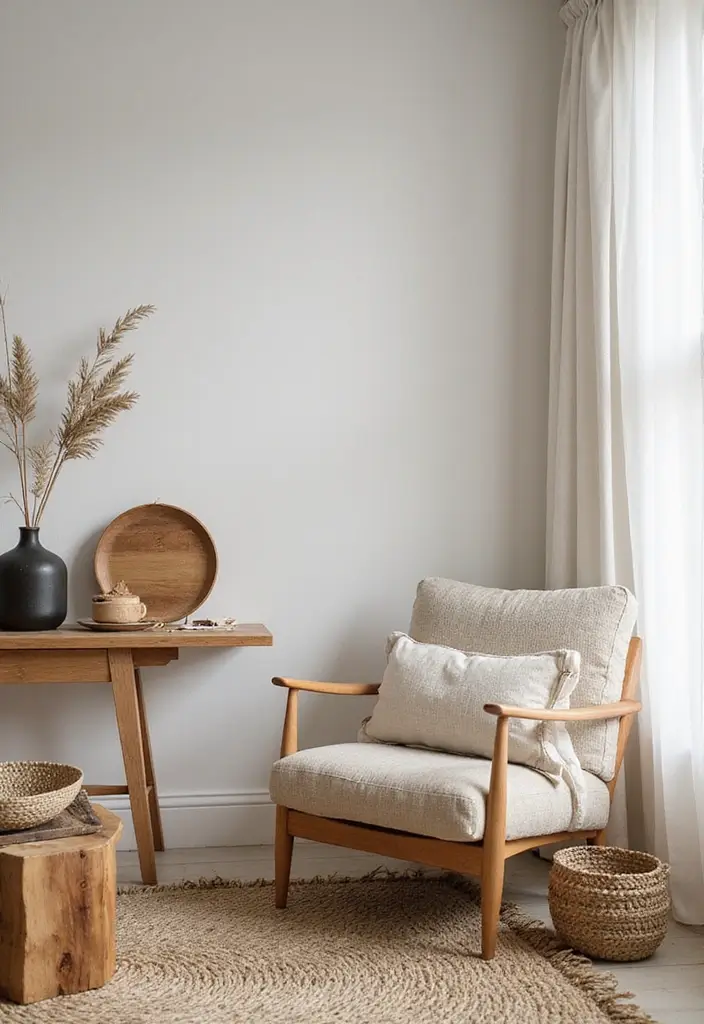
Incorporating sustainable materials can elevate your minimalist home while being environmentally conscious.
Look for items made from organic cotton, bamboo, or recycled metals that align with your values and complement a clean aesthetic.
Ideas include:
– Furniture made from reclaimed wood or bamboo for a modern touch.
– Eco-friendly rugs that add comfort without sacrificing style.
– Decorative pieces made from upcycled materials to tell a story.
By choosing sustainability, you create a home that resonates with your values while enhancing its beauty.
22. Customizable Spaces
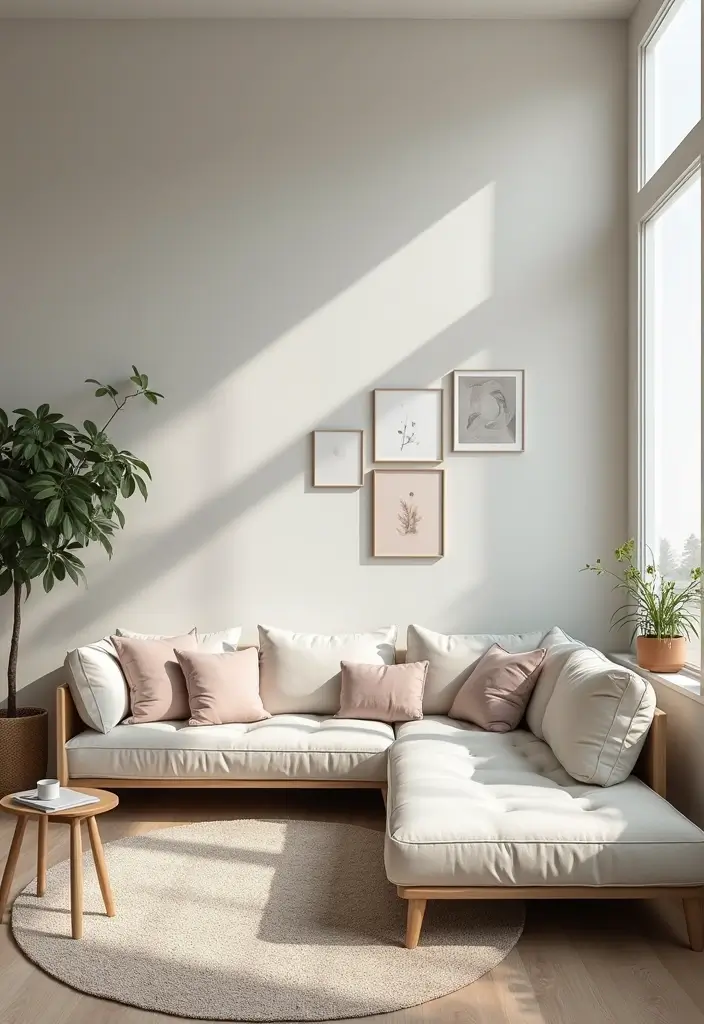
Creating customizable spaces allows for versatility while adhering to minimalist principles.
Use modular furniture that can be rearranged for different activities, making your home adaptable to your needs. This approach ensures your space remains uncluttered and functional.
Consider:
– Foldable chairs or tables that can be stored away when not in use.
– Cushions that can double as seating or decor.
– Movable partitions to create temporary spaces.
This flexibility keeps your home dynamic, making it easier to maintain minimalism.
23. Emphasis on Natural Light
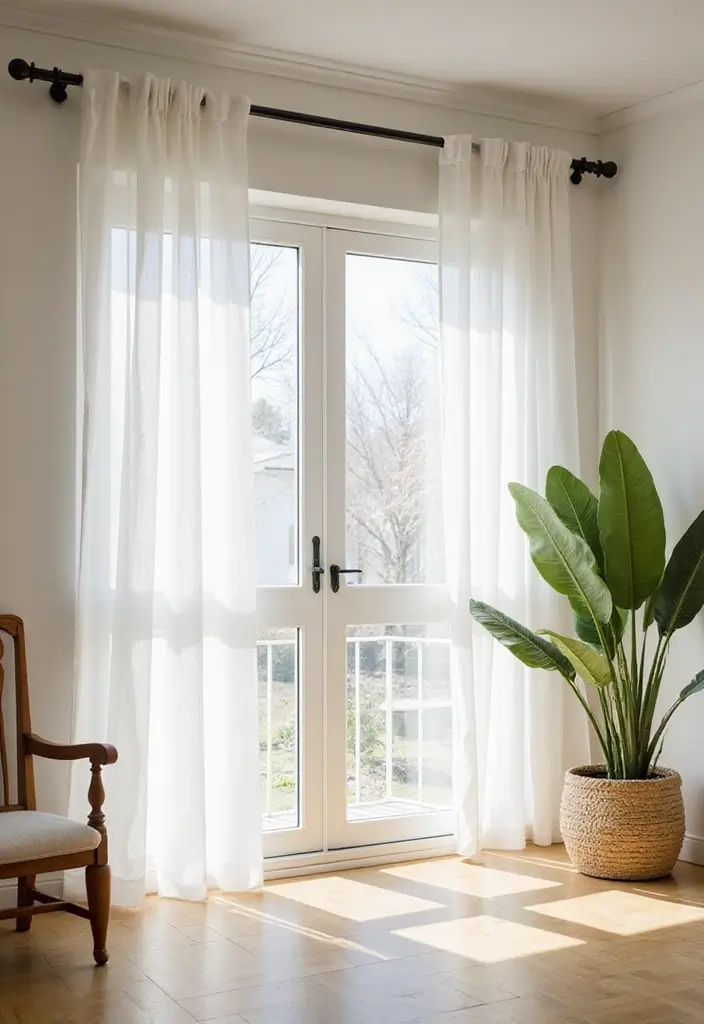
Natural light is a cornerstone of minimalist design, bringing warmth and energy to your home.
Maximize this resource with large windows, skylights, and reflective surfaces that enhance brightness. The result is a lively and welcoming atmosphere.
Ways to enhance natural light include:
– Avoiding heavy drapery; instead, use sheer curtains for privacy.
– Choosing light-colored walls to amplify brightness.
– Positioning mirrors to reflect light around the space.
Emphasizing natural light can create an uplifting environment that complements a minimalist aesthetic.
24. Flexible Room Designs
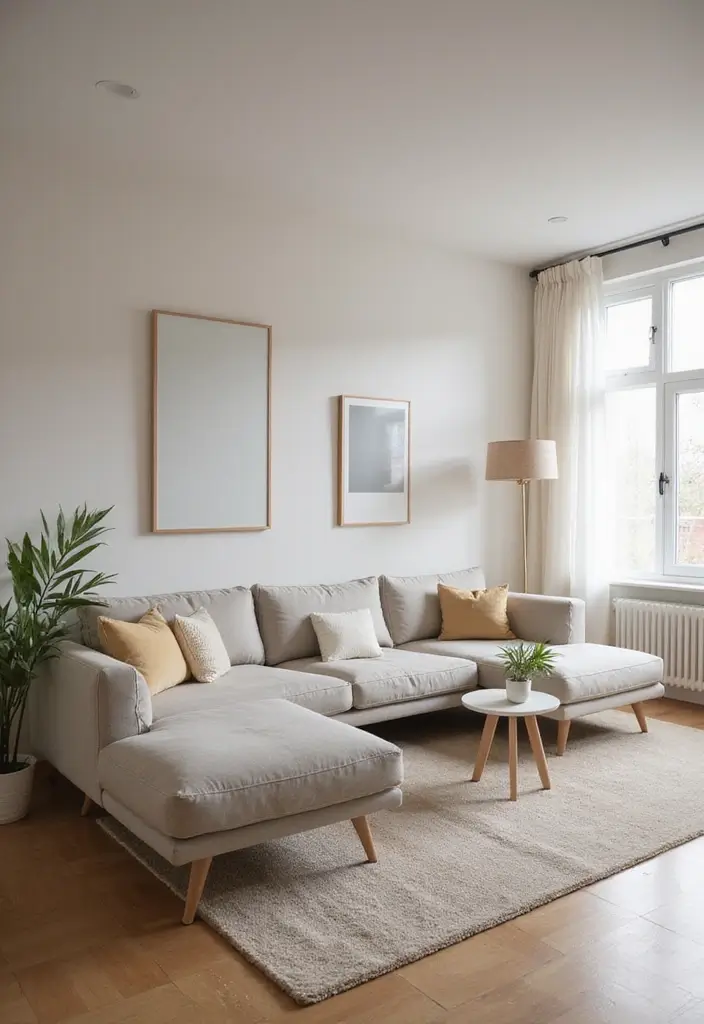
Flexible room designs enhance functionality while adhering to minimalism.
Consider open floor plans that allow for movement and adaptability, transforming spaces depending on your needs. This approach keeps your home feeling spacious and uncluttered.
Additional concepts:
– Use furniture on wheels for easy rearrangement.
– Incorporate folding screens to create distinct areas as required.
– Keep decor minimal to ensure a cohesive flow throughout.
Flexibility ensures your home evolves with you, maintaining a contemporary yet timeless appeal.
25. Incorporation of Indian Crafts
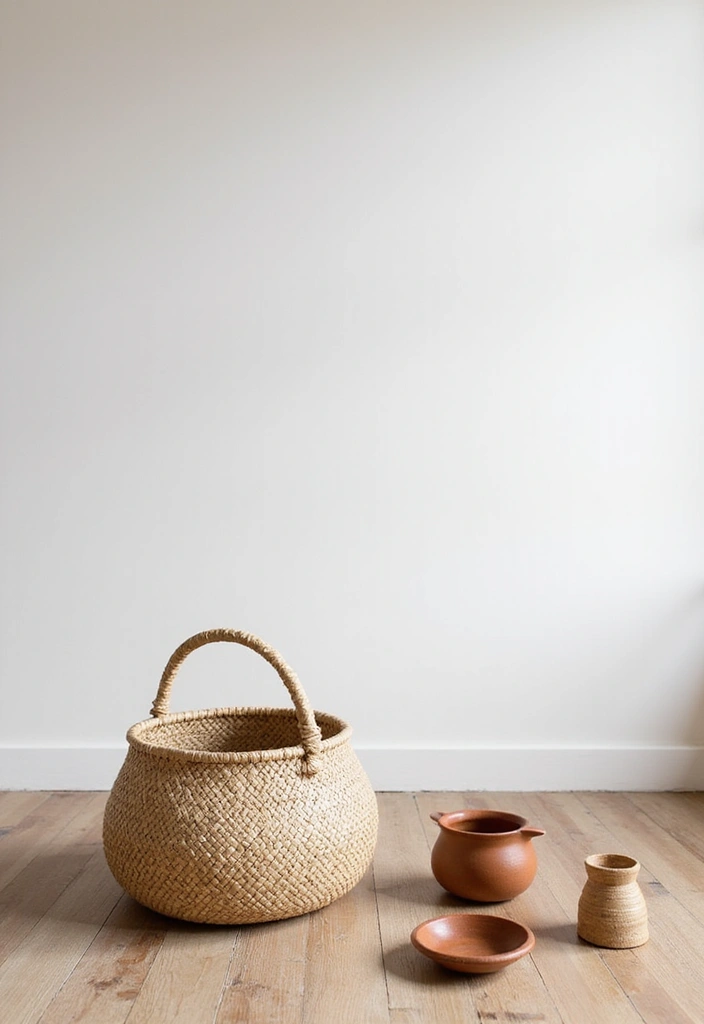
Incorporating Indian crafts into your decor can add character while maintaining a minimalist aesthetic.
Choose handcrafted items that reflect skill and tradition, like a handwoven basket or a ceramic piece. These unique elements become focal points in a clean layout.
for integration:
– Use a few bold pieces rather than cluttering your space.
– Showcase crafts in well-lit areas to highlight their beauty.
– Pair with neutral backgrounds for contrast.
This approach keeps your home both stylish and culturally rich.
26. Balancing Old with New
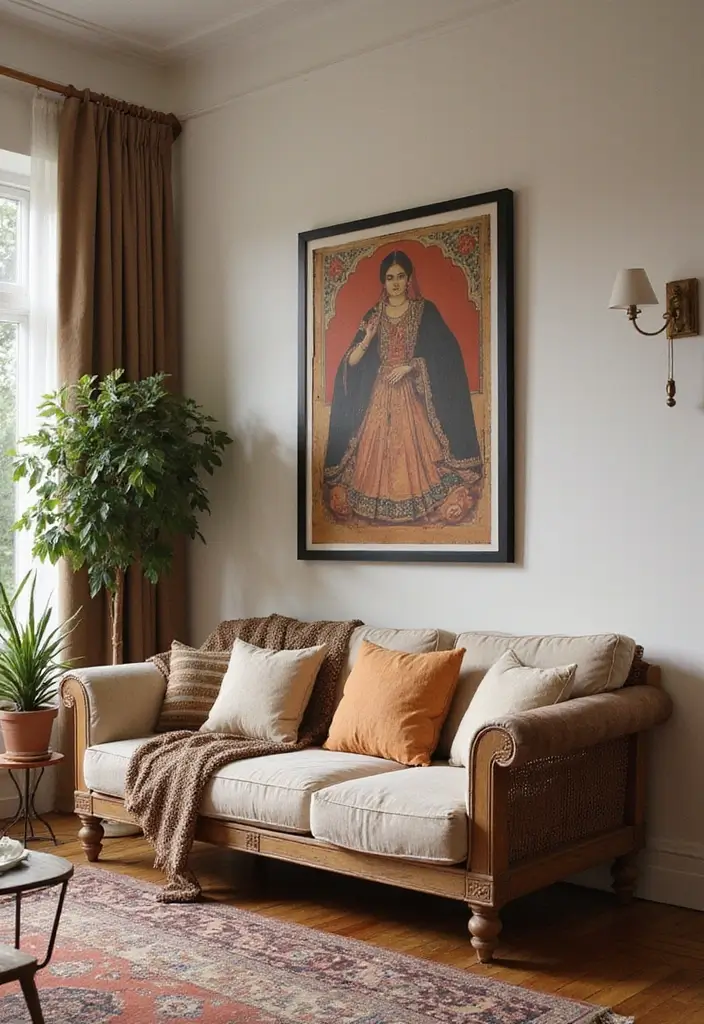
Striking a balance between old and new can create a beautifully layered home.
Incorporate vintage Indian pieces alongside modern decor to celebrate your heritage while still appealing to contemporary aesthetics. This blend can add depth to your minimalist style.
Consider:
– A vintage Indian trunk serving as a coffee table alongside a modern sofa.
– Using contemporary art to frame traditional textiles.
– Combining sleek furniture with antique accents for a harmonious feel.
This strategy maintains a minimalist look while highlighting the beauty of historical crafts.
27. Use of Open Spaces
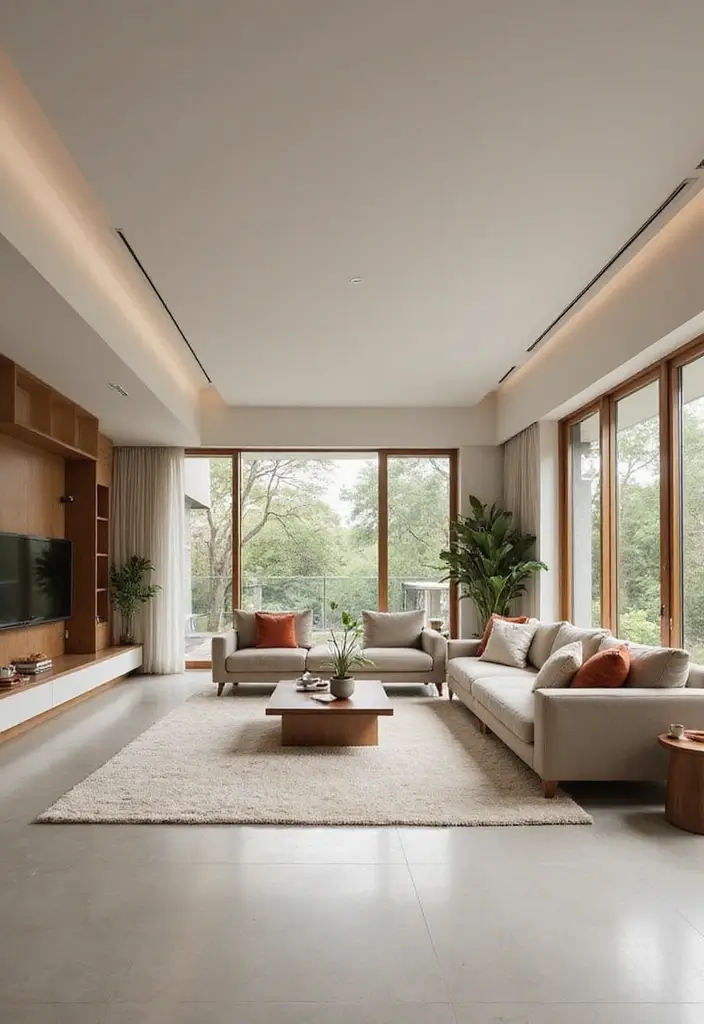
In a minimalist Indian home, utilizing open spaces promotes a sense of freedom and flow.
Choose furniture that doesn’t block sightlines, ensuring areas remain interconnected and inviting. This layout fosters an easy movement throughout your home.
Strategies for achieving open spaces:
– Keep furniture low to maintain visual connection across rooms.
– Use area rugs to define spaces without visually enclosing them.
– Avoid unnecessary walls or partitions to keep the flow intact.
Creating open spaces enhances your home’s aesthetic while celebrating the feeling of tranquility.
28. Thoughtful Color Blocks
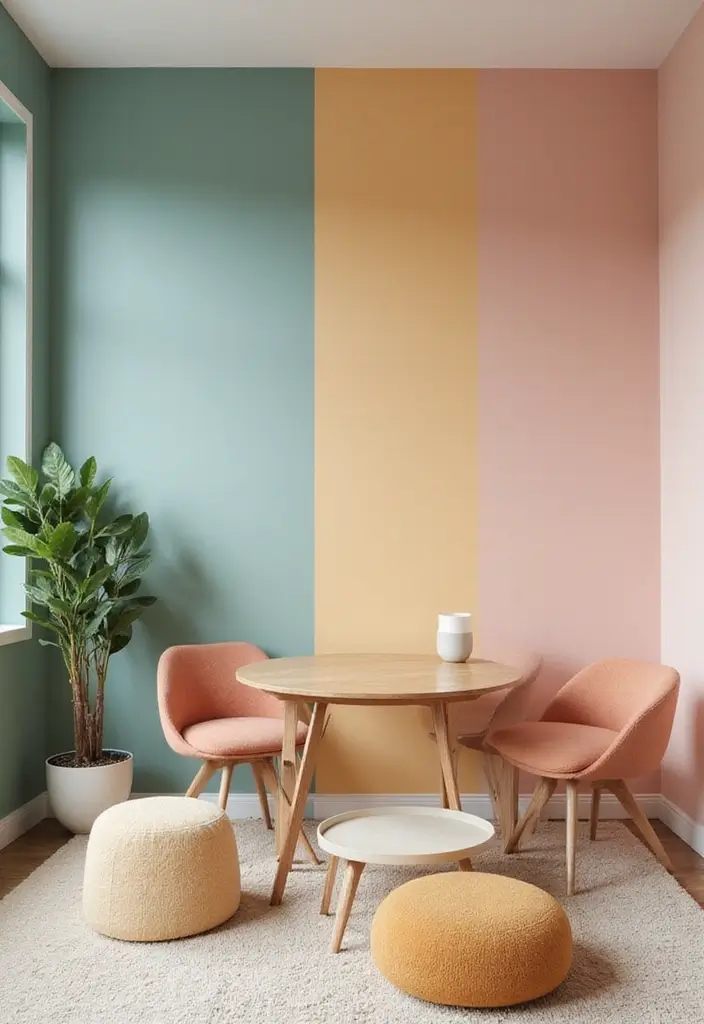
Thoughtful color blocking can add a playful yet minimalist charm to your home.
Use simple shapes and contrasting colors to define spaces without overwhelming them. This method can create visual interest while maintaining an organized look.
for color blocking:
– Choose a few complementary colors to keep cohesion.
– Apply color blocks to walls or furniture to serve as focal points.
– Balance bright colors with neutral tones to maintain a minimalist feel.
This trend ensures your home embraces individuality while still honoring simplicity.
29. Soft, Natural Lighting
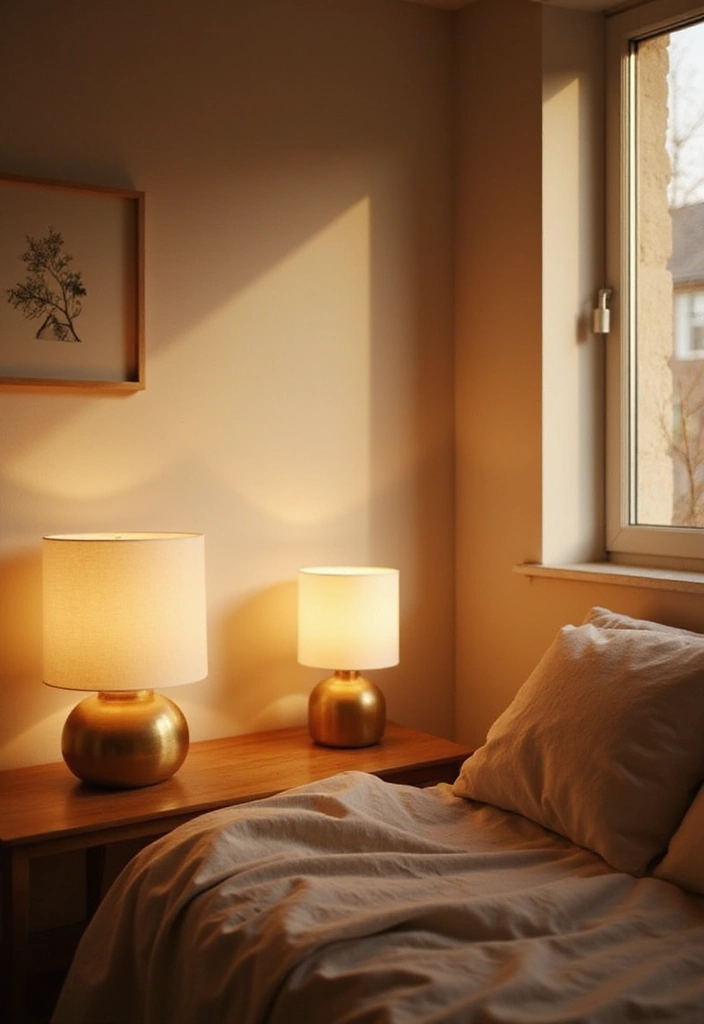
Soft, natural lighting can enhance the ambiance of a minimalist home.
Consider using strategically placed lamps with warm bulbs to complement daylight, creating a cozy atmosphere during the evenings. Lighting can make a significant difference in mood and energy.
Best practices for soft lighting include:
– Use dimmers to adjust brightness according to the time of day.
– Incorporate lighting fixtures that reflect your style without being overpowering.
– Keep the focus on natural light sources during the day.
This approach ensures your home feels inviting and restful, regardless of the time.
30. Embracing Personal Sentiments
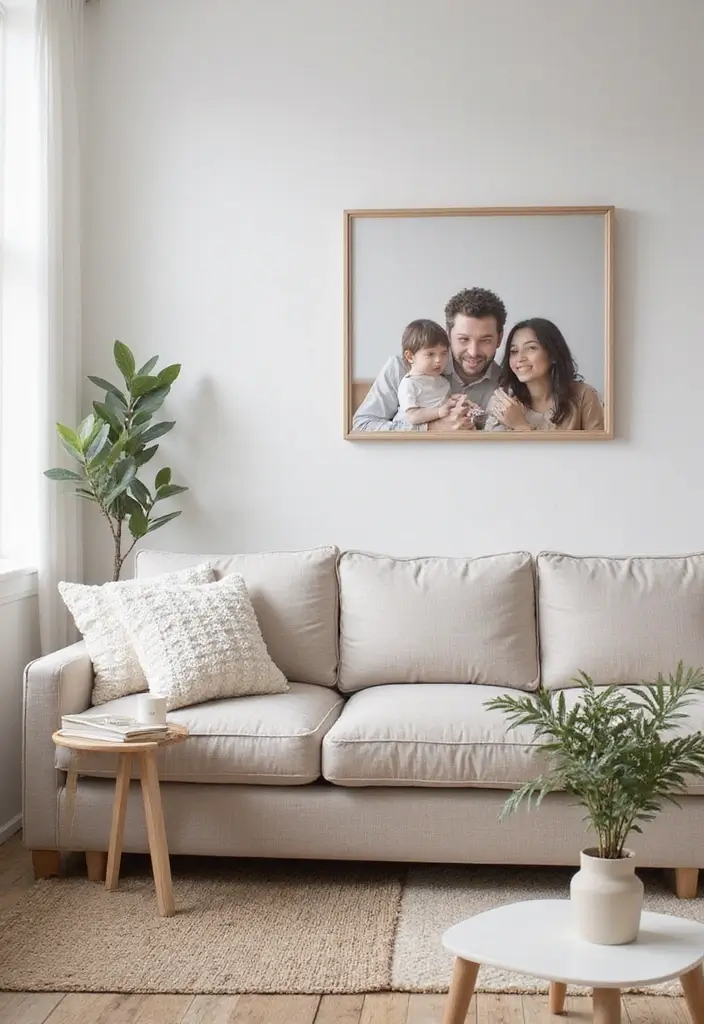
Finally, no minimalist home is complete without personal touches that reflect your journey and sentiments.
This could be a framed family photo in a simple frame, or a memento from your travels displayed on a clean surface. These elements make your space truly yours.
To embrace personal sentiments:
– Keep the number of personal items to a minimum for impact.
– Choose frames or display options that align with your minimal aesthetic.
– Rotate items occasionally to refresh your space.
These thoughtful additions create a warm and inviting environment while celebrating your unique story.
Conclusion
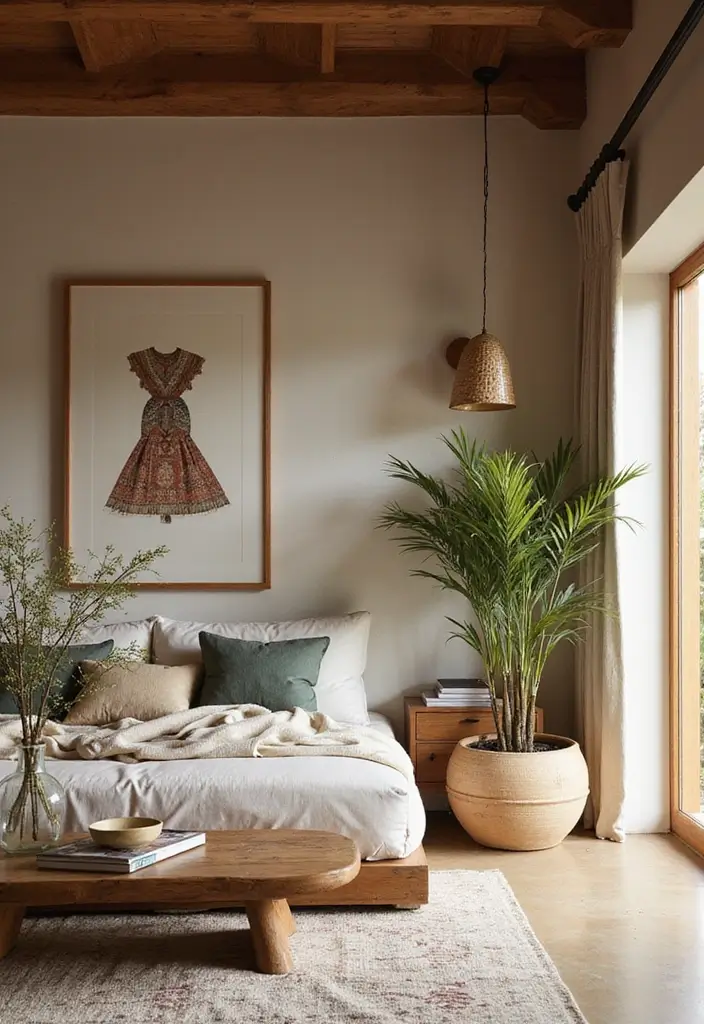
Blending minimalism with Indian culture creates a home that’s not just stylish but also deeply meaningful.
These ideas encourage you to embrace simplicity while celebrating the rich heritage that defines Indian decor.
Whether you adopt one or many of these concepts, remember that your home should reflect who you are, striking that perfect balance between modern aesthetics and cultural pride.
Frequently Asked Questions
What Are the Key Elements of Minimalist Indian Home Decor?
Minimalist Indian home decor beautifully combines simplicity with cultural richness. Key elements include natural materials like wood and stone, earthy color palettes, and traditional textiles used in understated ways. By focusing on functional furniture and thoughtfully curated cultural accents, you can create a serene and stylish living space that reflects your heritage.
How Can I Incorporate Sustainable Materials in My Minimalist Indian Home?
Incorporating sustainable materials is a fantastic way to enhance your minimalist Indian home. Look for furniture made from reclaimed wood, organic fabrics, and recycled metals. Additionally, use natural fibers for accents like rugs and cushions, ensuring that each piece not only looks good but also contributes to a healthier planet. Sustainable choices help create a home that feels good inside and out!
What Are Some Simple Ways to Add Cultural Home Accents Without Clutter?
Adding cultural home accents can be accomplished without clutter by opting for a few standout pieces. Consider using open shelving to display curated artifacts like a hand-painted pottery or a brass diya (lamp). This approach allows you to showcase your heritage while maintaining a clean and minimalist aesthetic. Remember, less is often more in minimalist decor!
How Do I Achieve a Serene Atmosphere in My Minimalist Indian Home?
To create a serene atmosphere, focus on natural light and earthy tones. Use large windows and sheer curtains to let sunlight filter in gently. Incorporate indoor plants to add freshness and purify the air. Additionally, choose soft textures and minimalistic lighting fixtures that create a calm ambiance. Together, these elements will enhance the tranquility of your space.
Can I Mix Modern and Traditional Styles in Minimalist Indian Decor?
Absolutely! Mixing modern and traditional styles is a hallmark of minimalist Indian decor. You can pair a sleek modern sofa with a carved wooden coffee table for an appealing contrast. This fusion not only celebrates your heritage but also keeps your home looking fresh and contemporary. Just remember to maintain a coherent color palette and balance to ensure a harmonious look.
Related Topics
minimalist indian home
indian interior design
sustainable decor
cultural accents
modern indian style
natural materials
simple aesthetics
eco-friendly design
minimalist lighting
indoor plants
home organization
open shelving

